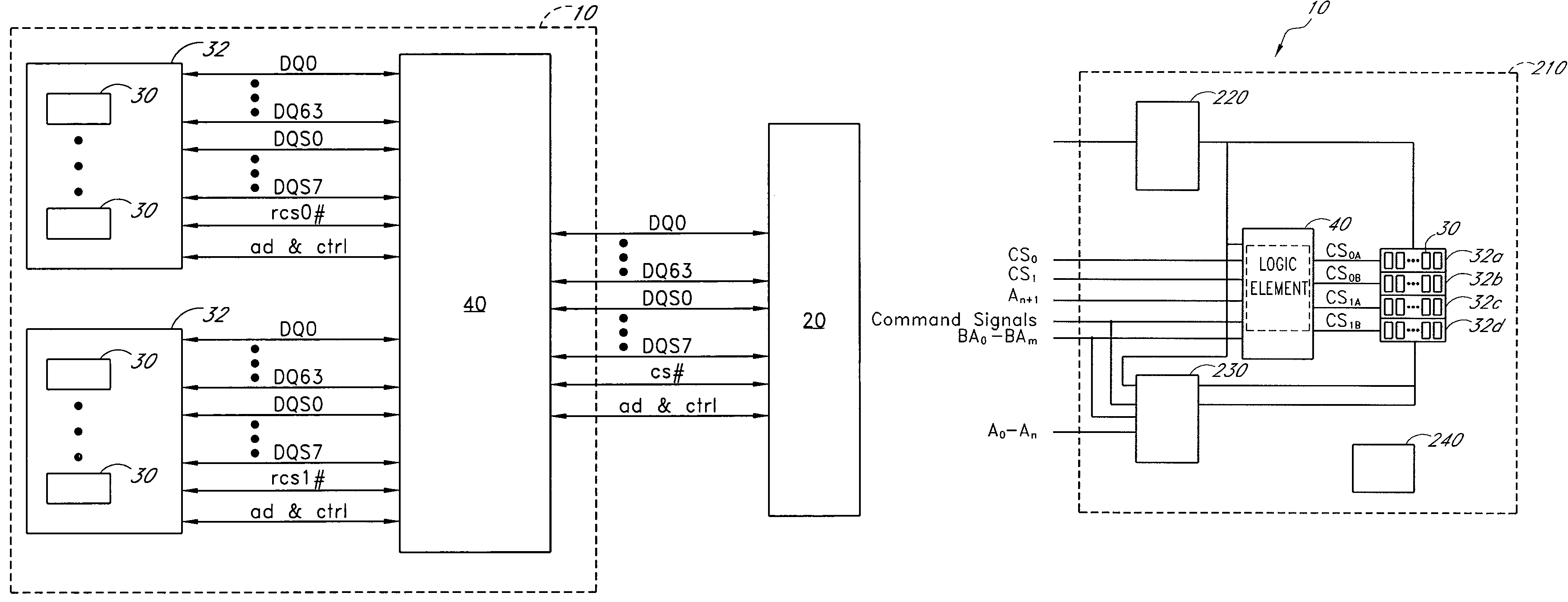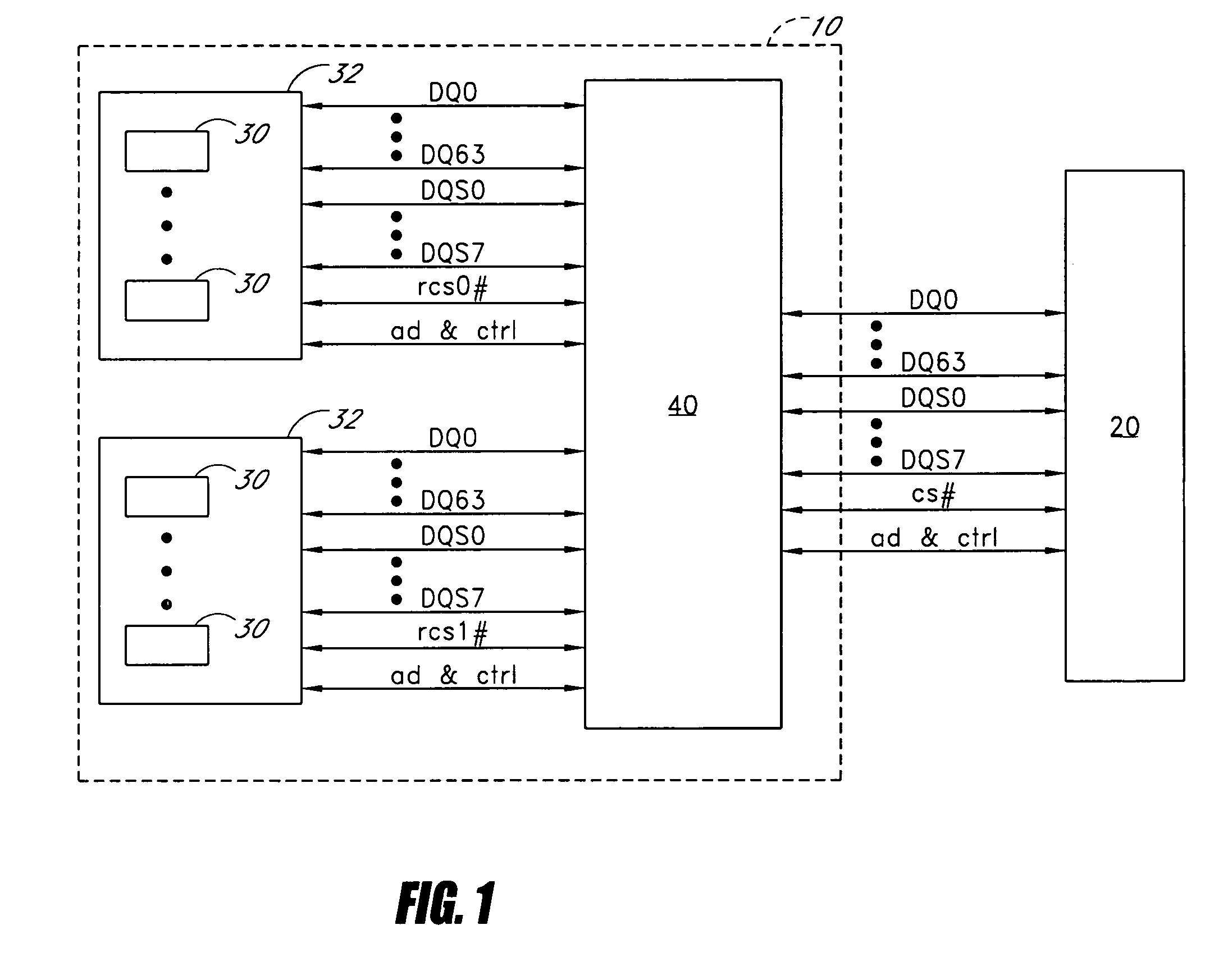Memory module with a circuit providing load isolation and memory domain translation
a memory module and load isolation technology, applied in the field of memory modules of computer systems, can solve the problems of imposing limitations on the size of memory arrays of memory modules, limited memory density that can be incorporated in each memory slot,
- Summary
- Abstract
- Description
- Claims
- Application Information
AI Technical Summary
Benefits of technology
Problems solved by technology
Method used
Image
Examples
example 1
[0059]
/ / ========================== declarationsregrasN_R, casN_R, weN_R;wireactv_cmd_R, pch_cmd_R, pch_all_cmd_R, ap_xfr_cmd_R_R;wirexfr_cmd_R,mrs_cmd,rd_cmd_R; / / - - - - - - - - - - - - - - - - - - - - - - - - - DDR 2 FETregbrs0N_R; / / registered chip selregbrs1N_R; / / registered chip selregbrs2N_R; / / registered chip selregbrs3N_R; / / registered chip selwiresel;wiresel_01;wiresel_23;wirerd_R1;wirewr_cmd_R,wr_R1;regrd_R2,rd_R3,rd_R4,rd_R5;regwr_R2,wr_R3,wr_R4,wr_R5;regenfet1,enfet2,enfet3,enfet4,enfet5,enfet6;wirewr_01_R1,wr_23_R1;regwr_01_R2,wr_01_R3,wr_01_R4;regwr_23_R2,wr_23_R3,wr_23_R4;wirerodt0_a,rodt0_b; / / ========================== logicalways @(posedge clk_in)beginbrs0N_R / / cs0brs1N_R / / cs1brs2N_R / / cs2brs3N_R / / cs3rasN_R casN_R weN_R endassign sel = ~brs0N_R | ~brs1N_R | ~brs2N_R | ~brs3N_R ;assign sel_01 = ~brs0N_R | ~brs1N_R ;assign sel_23 = ~brs2N_R | ~brs3N_R ;assign actv_cmd_R = !rasN_R & casN_R & weN_R; / / activate cmdassign pch_cmd_R = !rasN_R & casN_R & !weN_R ; / / pch...
example 2
[0136]
always @(posedge clk_in)beginrs0N_R rasN_R casN_R weN_R end / / Gated Chip Selectsassignpcs0a_1 = (~rs0_in_N & ~ras_in_N & ~cas_in_N) / / ref,md reg set| (~rs0_in_N & ras_in_N & cas_in_N) / / ref exit, pwr dn| (~rs0_in_N & ~ras_in_N & cas_in_N & ~we_in_N & a10_in) / / pchg all| (~rs0_in_N & ~ras_in_N & cas_in_N & ~we_in_N & ~a10_in & ~ba2_in) / / pchg single bnk| (~rs0_in_N & ~ras_in_N & cas_in_N & we_in_N & ~ba2_in) / / activate| (~rs0_in_N & ras_in_N & ~cas_in_N & ~ba2_in) / / xfr;assignpcs0b_1 = (~rs0_in_N & ~ras_in_N & ~cas_in_N) / / ref,md reg set| (~rs0_in_N & ras_in_N & cas_in_N) / / ref exit, pwr dn| (~rs0_in_N & ~ras_in_N & cas_in_N & ~we_in_N & a10_in) / / pchg all| (~rs0_in_N & ~ras_in_N & cas_in_N & ~we_in_N & ~a10_in & ba2_in) / / pchg single bnk| (~rs0_in_N & ~ras_in_N & cas_in_N & we_in_N & ba2_in) / / activate| (~rs0_in_N & ras_in_N & ~cas_in_N & ba2_in) / / xfr; / / ------------------------------------- always @(posedge clk_in)begina4_r a5_r a6_r a10_r ba0_r ba1_r ba2_r q_mrs...
example 3
[0138]
/ / latched a13 flags cs0, banks 0-3always @(posedge clk_in)if (actv_cmd_R & ~rs0N_R & ~bnk1_R & ~bnk0_R) / / activatebegin1_a13_00 endalways @(posedge clk_in)if (actv_cmd_R & ~rs0N_R & ~bnk1_R & bnk0_R) / / activatebegin1_a13_01 endalways @(posedge clk_in)if (actv_cmd_R & ~rs0N_R & bnk1_R & ~bnk0_R) / / activatebegin1_a13_10 endalways @(posedge clk_in)if (actv_cmd_R & ~rs0N_R & bnk1_R & bnk0_R) / / activatebegin1_a13_11 end / / gated casassign cas_i = ~(casN_R);assign cas0_o = ( ~rasN_R & cas_i)| ( rasN_R & ~1_a13_00 & ~bnk1_R & ~bnk0_R & cas_i)| ( rasN_R & ~1_a13_01 & ~bnk1_R & bnk0_R & cas_i)| ( rasN_R & ~1_a13_10 & bnk1_R & ~bnk0_R & cas_i)| ( rasN_R & ~1_a13_11 & bnk1_R & bnk0_R & cas_i);assign cas1_o = ( ~rasN_R & cas_i)| ( rasN_R & 1_a13_00& ~bnk1_R & ~bnk0_R & cas_i)| ( rasN_R & 1_a13_01& ~bnk1_R & bnk0_R & cas_i)| ( rasN_R & 1_a13_10& bnk1_R & ~bnk0_R & cas_i)| ( rasN_R & 1_a13_11& bnk1_R & bnk0_R & cas_i);assignpcas_0_N = ~cas0_o;assignpcas_1_N = ~cas1_o;assignrd0_o_R1 = rasN_R...
PUM
 Login to View More
Login to View More Abstract
Description
Claims
Application Information
 Login to View More
Login to View More - R&D
- Intellectual Property
- Life Sciences
- Materials
- Tech Scout
- Unparalleled Data Quality
- Higher Quality Content
- 60% Fewer Hallucinations
Browse by: Latest US Patents, China's latest patents, Technical Efficacy Thesaurus, Application Domain, Technology Topic, Popular Technical Reports.
© 2025 PatSnap. All rights reserved.Legal|Privacy policy|Modern Slavery Act Transparency Statement|Sitemap|About US| Contact US: help@patsnap.com



